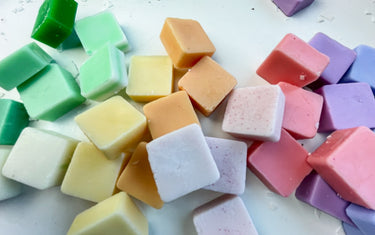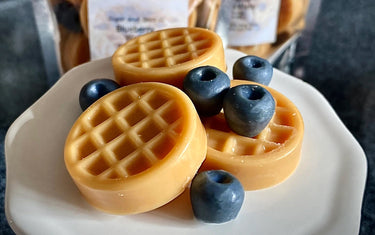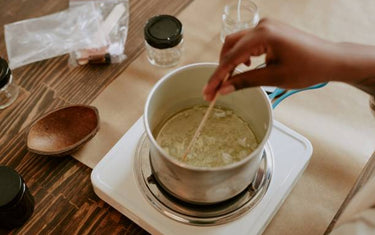13 min read / 24 February 2025 / yasmin sharp
4. Wax Melts Guide to Fragrances, Blends and Safety Tips
Learn the complete wax melt making process, from sourcing ingredients to pouring and setting, with tips, techniques, and troubleshooting for perfect results.
Share this post

Wax melts are pieces of scented wax that release a scented fragrance to create a fresh and engaging aroma when melted in a burner.
There has been a boom in their popularity over the past few years, not only because they are easy to create, but you can make a sizeable batch on even the smallest of budgets.
The key to success often lies in using the right combination of fragrance oils for wax melts, which will help you make better quality products and enhance the enjoyment you and others get from every burn.
Our guide covers every aspect of the fragrance-making process, giving you the building blocks to move from amateur to expert in no time at all.

1. Fragrance Oils vs. Essential Oils
You’ll have a choice between using fragrance oils and essential oils for your wax melt fragrance, and it’s helpful to understand the key differences between them.
Fragrance Oils
There are two different types of fragrance oils you can use in your wax melts:
- Synthetic fragrance oils: Chemical compounds are used to make synthetic fragrance oils and they do not contain any natural elements, which allows the scent to last longer than essential oils.
- Natural fragrance oils: These are also man-made oils that are constructed in a laboratory. Isolates from various natural aromatic materials are combined to form the finished scent.
Benefits of fragrance oils
- Longer lasting scent: Because fragrance oils are created in a lab, whether it's using synthetic or natural components, the scent can usually last for longer compared to essential oils.
- Varied selection: Fragrance oils are designed to mimic a real-world scent, which can be anything from your favourite Christmas aroma to candy floss or a cosy fireplace.
- Cost-effective: The lab-based production of fragrance oils means they are often cheaper to buy than essential oils, which is ideal for anyone working on a smaller budget.
What else do you need to consider?
The ability to create scents artificially that may not be possible with essential oils is a plus, although not everyone is a fan. Some purists prefer to interact only with oils that have come directly from nature, as they feel they are more authentic.
There is also the aromatherapeutic angle to consider. Fragrance oils can be used to create a calming and relaxing atmosphere, but unlike essential oils they are not able to provide any potential health benefits.
Essential Oils
Essential oils are extracted from plants, flowers and fruits to produce highly concentrated oils that can be used in aromatherapy. Steam distillation or cold pressing extraction methods are used to remove the oils from the natural element, helping them to retain many of their original components.
Benefits of essential oils
- Natural and authentic: Using essential oils allows you to tap directly into nature, bringing its original essence into your home. The scent is 100% authentic and completely representative of its original source.
- Health and wellness: The natural scent is one thing, but the aromatherapy benefits can be useful for easing stress and managing minor ailments. It helps to create a holistic experience for an all-round natural treatment package.
- Eco-friendly: Buying essential oils that have been sourced responsibly ensures you are maintaining a commitment to taking care of the planet. They are also non-polluting and biodegradable, provided they are disposed of correctly.
What else do you need to consider?
The main thing to consider with essential oils is their toxicity, as they are highly concentrated and can cause skin irritations or allergic reactions. This can also happen when they are used in wax melts, so suitable health warnings should be used if they are being made for sale.
When essential oils are used in wax melts, the scent throw does not tend to be as strong as fragrance oils. This is not to say there is no scent at all, but it may not offer the aroma level you were first expecting.
Choosing between essential oils and fragrance oils
There is no definitive conclusion on when it is better to use an essential oil or fragrance oil for your wax melts. Ultimately, it comes down to personal choice and the type of scent you want to interact with.
The aromatherapeutic benefits offered by essential oils may be preferred by some, especially if you are looking for a natural way to reduce stress, improve sleep or calm headache symptoms.
Similarly, you may choose to add fragrance oils to your wax melts if you want to recreate a specific aroma that natural oils cannot provide, such as the smell of the ocean or the scent of freshly cleaned washing.
This is also something to take into consideration if you are making wax melts as part of a business. If you want to target an eco-conscious market, then essential oils are the way to go, while using fragrance oils allow you to create wax melts based on more specific aromas.

2. Blending Scents
The art of combining essential oils and mixing fragrance oils is made easier once you know more about how scent notes work.
Basics of Scent Blending
- Top notes: When you inhale a scent, you will initially come into contact with the top note. These are mostly light and fresh (most citrus oils fall into this category) and although they don’t last as long as the middle or base notes, it should encourage you to dig deeper into the depth of the scent.
- Middle notes: The middle scent is classed as the main body of the fragrance, making it the most important for your blend. Herbal or floral scents like rosemary or lavender tend to be used for middle notes, which will linger for longer than a top note.
- Base notes: Base note essential oils and fragrance oils serve as the foundation of your blend, providing the longest-lasting aroma. They add depth and fullness to the scent and can remain on the skin for anywhere between 12-24 hours. Frankincense and ylang ylang are popular base note choices for fragrance recipes.
Complementary Scents
Some essential oil combos you can try include:
- Citrus oils like lemon, orange and grapefruit blend well with floral, herbal and spicy oils.
- Spicy oils like baked cinnamon and pumpkin spice are ideal for mixing with citrus, floral and earthy oils.
- Earthy oils like amber and sandalwood blend well with spicy, floral, citrus and herbal oils.
- Herbal oils like oregano and sage combine well with spicy and earthy oils.
- Floral oils like fresh linen and floral musk blend well with earthy, spicy and citrus-based oils.
Blending Techniques
Now you know what works well together, how do you make a balanced blend? The following tips will tell you more.
Proportions
- Follow the 30/50/20 rule for your wax melts fragrance. This means 30% will be made up of the top note, 50% from the middle note and 20% from the base note.
- As a practical example, if you are using 10 drops for the fragrance, 3 would be added for the top note, 5 for the middle note and 2 for the base note.
- Apply the same ratio even if you are using more than three different oils. For example, if you are using two oils for the top note, you could use 15% from each one and so on.
The fun part of blending oils is making something fresh and unique, so feel free to experiment as much as you want. If blending by note feels too restrictive then switch to a method that works for you – some of the most exciting fragrances are created through happy accidents.
Helpful tips
- Try to use a small amount of oil (1-2 drops of each) at first to see how they combine, which will help to avoid wastage.
- Keep track of the oils you use and the amounts so you can recreate the ones you like again in the future.
- Essential oil and fragrance oil notes tend to mature over a few days, so what you first smell but change slightly after the blend has had a few days to combine and settle.
Popular Blends
You can create fragrance and essential oil combos to match the changing seasons, so you could try:
Spring blend
- 4 x drops lemon essential oil
- 3 x drops rosemary essential oil
- 2 x drops frankincense essential oil
- 1 x drop eucalyptus oil
Summer blend
- 5 x drops tangerine essential oil
- 3 x drops ylang ylang essential oil
- 2 x drops lavender essential oil
Autumn blend
- 2 x drops ginger essential oil
- 4 x drops cinnamon essential oil
- 6 x drops sweet orange oil
Winter blend
- 5 x drops sweet orange essential oil
- 3 x drops peppermint essential oil
- 2 x drops frankincense essential oil
Mood-Based Blends
A wax melt’s fragrance can also have a positive effect on mood. Here are a few ideas to give you some inspiration:
Anti-stress blend
- 3 x drops Lavender essential oil
- 3 x drops Geranium essential oil
- 2 x drops Lemon essential oil
Energy boosting blend
- 2 x drops of Eucalyptus essential oil
- 2 x drops of Peppermint essential oil
- 2 x drops of Lemon essential oil
Calm and relaxing blend
- 4 x drops Lavender essential oil
- 3 x drops Bergamot essential oil
Focus and concentration blend
- 4 x drops Lemon essential oil
- 3 x drops Peppermint essential oil
- 1 x drops Rosemary essential oil

3. Fixatives and Solvents
What Are Fixatives?
A fixative is a substance used to stabilise the raw materials used in a fragrance oil, helping it to maintain its strength and longevity in a wax melt. Synthetic chemicals, essential oils and natural resins can all be used as fixatives.
The evaporation of the more volatile elements of a fragrance are equalised by adding a fixative, balancing out the compounds to create a more rounded and effective scent profile.
Common Fixatives
Essential oils can be used as a natural fixative in wax melt recipes, with some of the more common ingredients being:
- Frankincense essential oil: The warm, resinous scent tends to work well as a fixative in wood and oriental-style fragrances, helping to create a longer-lasting scent.
- Sandalwood essential oil: This is an ideal fixative for enhancing floral fragrances, with the warm, woody scent providing the ideal balance.
- Vetiver essential oil: If you need to give more balance to unisex and masculine blends then vetiver oil’s deep, smoky aroma can add the right amount of depth.
Alternatively, you could use a synthetic chemical as a fixative for your wax melts, such as:
- Galaxolide: The sweet scent of this synthetic musk is often used to add more depth to the mixture to improve its longevity.
- Ambroxide: Also known as Amboxan, this chemical is derived from sclareol, producing a scent similar to ambergris to increase the fragrance’s staying power.
- Hedione: This fixative has a jasmine-like scent that is commonly used to enhance and lift the more delicate floral notes featured in the recipe.
Understanding Solvents
What are solvents?
Solvents are used during the dilution process in perfumery, helping to extract, dissolve or suspend raw materials without impacting the chemical make-up of the substances they come into contact with.
They have a crucial role to play in ensuring that all the parts of the mixture are the same, which creates a consistent and reliable fragrance. When applied to a fragrance mixture that is being used in a wax melt recipe, oils can be easily dissolved, and the scent distributed more evenly.
Types of Solvents
Solvents commonly used in wax melts include:
- Benzyl benzoate: This is an ester of benzyl alcohol and compatible with most wax types, which gives more versatility with your wax melts.
- Diethyl phthalate: Another option that usually works well with most types of wax, although if used excessively it can cause fragrance bleeding.
- Dioctyl adipate: If you need to bridge differences with wax in certain spicy or rich-type fragrances, then this heavy solvent could offer the answer.
Application in Wax Melts
Making fragrance oils for wax melts is a delicate balancing act that requires you go through an ongoing series of trials and tests.
The scent of your fixative should complement the other ingredients being used in the fragrance to help you find the right balance. Of course, you may not get it right the first time, as is quite often the case after testing it on wax melt, so you will need to adjust the quantities of each ingredient.
Once you have added the fixative, solvent and other ingredients, allow time (overnight is good) for the fragrance to blend. The scent is likely to change during this period and you will have a better idea of how it will work in the wax once it has settled.
Blending oils requires time and patience, but the reward of making something fresh and unique is well worth it in the end.

4. Fragrance Safety and Regulations
Whether you are mixing essential oils or blending fragrance oils, you will need to take a few precautions to keep you and those around you safe.
Skin Safety
Both types of oils are highly concentrated so to prevent direct skin contact try to use the following:
- Wear gloves, long-sleeved and legged clothing and cover your feet when handling the oils, as they can cause skin irritation and/or allergic reactions.
- If you have long hair, tie it back and wear eye goggles to protect against splashbacks.
- Keep the oils away from naked flames and other heat sources and do not smoke when you are making your wax melts.
- Routinely wash your hands as you are handling the oils to ensure your skin is protected.
Respiratory Safety
- When you are combining essential oils or fragrance oils, ensure you are working in a well-ventilated space.
- If needed, open nearby windows to increase the airflow, as this will help to reduce the inhalation of toxic fumes.
- Consider wearing reusable respirators to give you more protection against the fumes.
Allergens
Due to their high concentration levels, these oils can also sometimes cause skin irritations and allergic reactions, even when they have been diluted.
This is particularly true of people with sensitive skin or those who regularly experience rashes, breathing difficulties or nasal symptoms.
If you become sensitive to an allergen it can cause reactions such as:
- Contact dermatitis: If undiluted oils come into contact with your skin, this can cause an allergic reaction in the form of a skin rash. This can include symptoms such as redness, itching, blisters and dry, thickened skin.
- Allergic rhinitis: This is a form of nasal allergy that can be caused by oil fumes. Essential oils are extracted from plants and flowers, so this may have more of an effect on people with pollen allergies. Common symptoms include stuffy and runny noses, itchy eyes and sneezing.
- Anaphylaxis: Although this is rare and a far more extreme reaction, it’s important to be aware of it so you can take necessary precautions. It’s a very strong allergic reaction that comes on suddenly to affect breathing and heart and can even be fatal. Symptoms include trouble breathing, nausea, vomiting, hives, tightness of the throat and fast heartbeat.
Regulatory Guidelines
If you are mixing essential oils and fragrance oils for wax melts that are going to be made available for sale, there are some legal guidelines that need to be taken into consideration.
IFRA Standards
The International Fragrance Association (IFRA) promotes the safe use of fragrance ingredients and serves as the global representative of the industry.
Members must follow their safety guidelines, although they are still recognised as the gold standard by everyone else. So, if you are not using IFRA recommended safety standards, then your products may not be viewed as safe or of the highest quality.
Labelling Requirements
When it comes the labelling requirements for wax melts that contain fragrance or essential oils, you need to ensure they include the following:
- A full list of ingredients, wax types and names of the oils used.
- Potential allergen risks that could be caused by the oils.
- Use of words like “Caution” or “Warning” to ensure people are aware of the potential health risks.
- Include reference to safety hazards, such as skin irritation, flammability etc.
- Instructions on how to safely use and store the melts, as well as warnings about avoiding eye contact and similar risks.
- Using pictograms will make it easier for people to understand the potential health risks.
- Add your full business name, physical address and contact details.
Safe Usage Tips
Safe storage of the oils will not only protect the user but can also extend the lifespan of the oils. Provide guidelines such as:
- Store in a dark space away from direct sunlight and other heat sources.
- Use cobalt glass bottles to protect the oil against UV rays.
- The bottle caps should be properly sealed when not in use.
- Ensure the space is always kept cool and dry.
- Keep out of reach of young children and pets.
Compliance
Wax melts that contain a toxic substance – which includes fragrance or essential oils – will need to comply with guidelines laid out by The General Product Safety Regulations 2005 (GPSR). This ensures your products are compliant with current health and safety laws in the UK and the EU.
Your business also needs to be in line with Companies Act 2006 guidelines, so your customers are fully aware of who they are buying from.
Aside from including your company name, legal ownership name and full company address on the label, these details should also feature on any other documentation associated with your business.

Conclusion
Hopefully our guide makes the idea of creating your own fragrance oil feel a little less daunting. Even though there’s a lot of information to digest, much of it is common sense and will quickly become second nature once you get things underway.
There’s an almost endless number of fragrance combinations you can play around with and as long as you stick to the basics – such as balancing fragrance notes and the importance of fixatives and solvents – you’ll soon find a method that works for your products.
Also remember to keep safe when handling raw materials and if you are selling wax melts that contain toxic substances they must comply with certain health and safety legal regulations.
Before you go, why not check out our wholesale service which offers exclusive discounts to members and gives you access to high-quality wax, dyes, fragrance oils and essential oils that can help take your wax melts to the next level.









